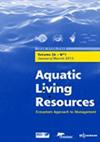在20世纪80年代渔业崩溃之前,巴西南部红鳉的种群动态:基线研究
IF 1.5
4区 农林科学
Q3 FISHERIES
引用次数: 3
摘要
自1972年以来,巴西南部对原本只有少量开发的雌雄同体鱼Pagrus Pagrus (L.)的大量开发导致了渔业在不到十年的时间里崩溃,四十年后没有恢复。本研究以1976年至1985年收集的样本为基础,对该物种的年龄结构、生长、繁殖和死亡率进行了分析,以提供过度开发发生前的基线。根据体表和耳石读数,最大估计年龄分别为21岁和26岁。年龄平均总长度(TL)雌雄间无差异,雌雄同体较小。所有鱼(未成熟、雌性、雌雄同体和雄性)的von Bertalanffy生长系数为L∞= 447 mm, k = 0.204, t0 = - 1.134 yr。雌性在所有尺寸中均占优势,雌雄同体仅在中等尺寸中存在,而雄性尽管在小尺寸中很少出现,但在较大的标本(TL bb0 400 mm)中占40%以上。产卵主要发生在晚春,产卵后的条件因子较低。根据von Bertalanffy生长参数估计自然死亡率M = 0.173 yr - 1。5 ~ 10岁全捕红鳉鱼的总死亡率(Z)和捕捞率(E)由1973年以前的0.24年和28%增加到1973年以后的0.49年和63%。两种不同的鳞片和耳石模式,一种有明显的环空,另一种有微弱或不存在环空,表明巴西南部的红色porgy种群可能不是同质的,可能包括没有完全混合的亚种群。本文章由计算机程序翻译,如有差异,请以英文原文为准。
The population dynamics of the red porgy Pagrus pagrus along southern Brazil, before its fishery collapse in the 1980s: a baseline study
The intense exploitation since 1972 of the formerly only slightly exploited protogynous hermaphroditic fish Pagrus pagrus (L.) in southern Brazil has led in less than a decade to the collapse of the fishery, with no recovery four decades later. In this study we analized the age structure, growth, reproduction and mortality of the species were studied based on samples collected from 1976 to 1985 to provide a baseline before the onset of overexploitation. Maximum estimated ages were 21 and 26 years based on scale and otolith readings, respectively. Mean total length (TL) at age did not differ between males and females, while hermaphrodites were smaller. The von Bertalanffy growth coefficients for all fish (immature, females, hermaphrodites and males) were L∞ = 447 mm, k = 0.204 and t0 = −1.134 yr. Change in growth was observed during the study period. Females were dominant at all sizes, hermaphrodites were only present up to intermediate sizes, and males, despite being infrequent at small sizes, made up over 40% among the larger specimen (TL > 400 mm). Spawning took place mainly in late spring and condition factors were lower after spawning. Natural mortality was estimated as M = 0.173 yr−1 based on the von Bertalanffy growth parameters. Total mortality (Z) and exploitation rate (E) estimated from catch curves of fully recruited red porgies aged five to ten years increased from 0.24 yr−1 and 28% before 1973 to 0.49 yr−1 and 63% in the following years. Two distinct scale and otolith patterns, one with well-marked annuli and another with faint or absent annuli, suggested that the red porgy stock off southern Brazil might not be homogeneous and may include subpopulations that do not fully mix.
求助全文
通过发布文献求助,成功后即可免费获取论文全文。
去求助
来源期刊

Aquatic Living Resources
农林科学-海洋与淡水生物学
CiteScore
2.30
自引率
0.00%
发文量
10
审稿时长
>24 weeks
期刊介绍:
Aquatic Living Resources publishes original research papers, review articles and propective notes dealing with all exploited (i.e. fished or farmed) living resources in marine, brackish and freshwater environments.
Priority is given to ecosystem-based approaches to the study of fishery and aquaculture social-ecological systems, including biological, ecological, economic and social dimensions.
Research on the development of interdisciplinary methods and tools which can usefully support the design, implementation and evaluation of alternative management strategies for fisheries and/or aquaculture systems at different scales is particularly welcome by the journal. This includes the exploration of scenarios and strategies for the conservation of aquatic biodiversity and research relating to the development of integrated assessment approaches aimed at ensuring sustainable and high quality uses of aquatic living resources.
 求助内容:
求助内容: 应助结果提醒方式:
应助结果提醒方式:


